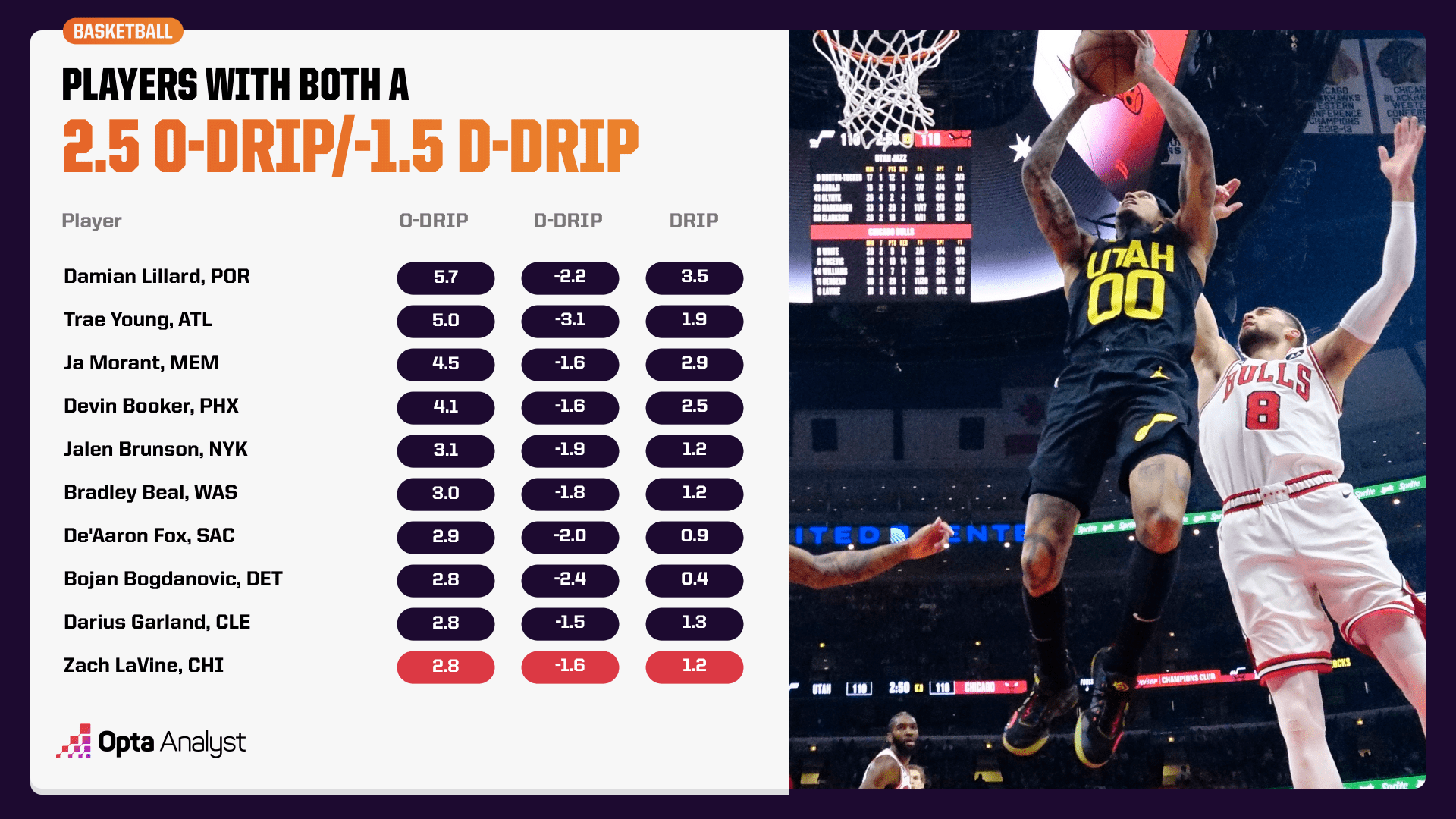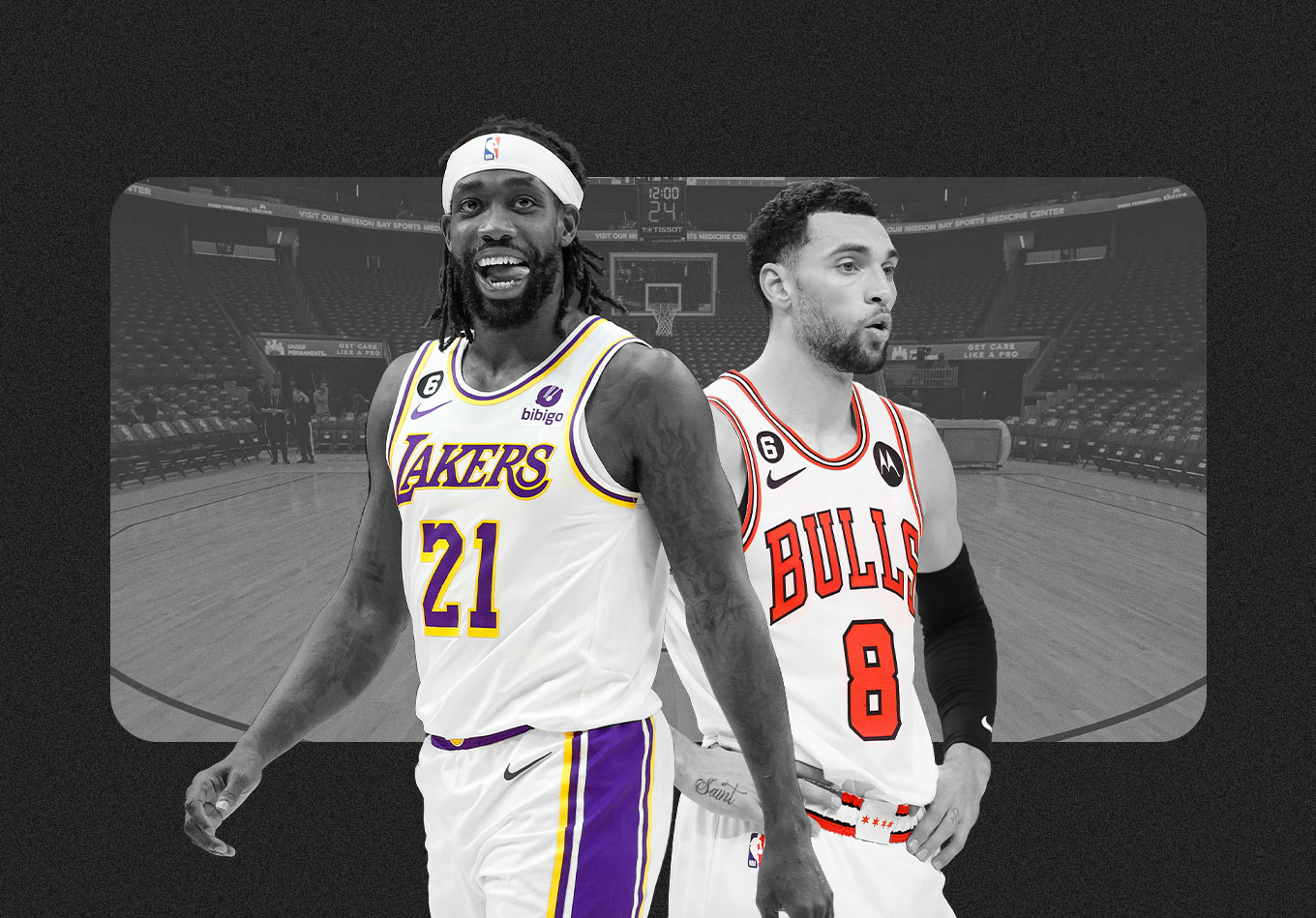Quick. You’re the general manager of a new NBA expansion team. You have the choice between two players and their contracts are exactly the same one-year deal in this hypothetical. The players are Zach LaVine and Patrick Beverley.
Which are you picking?
If you picked LaVine, congratulations! You’re probably a human that has watched the NBA in the last couple of seasons. Almost any fan of the league would take LaVine, and the general managers seem to agree, as LaVine was rewarded with a max contract this past offseason.
But DRIP, our all-encompassing stat that projects how good a player is at this moment in time, raises some eyebrows by ranking Beverley as the 56th-best player in the league and Zach LaVine as the 65th-best player in the league.
And DRIP isn’t alone. 538’s RAPTOR thought Beverley was better than LaVine last season, as did BPM, which can be found on Basketball Reference.
Well, if AI thinks something this crazy, we can all agree Skynet isn’t happening anytime soon, right? That’s a relief.
But is there more to this player comparison (or sub in the numerous other examples of players ranked much higher/lower in advanced metrics than in common opinion) than initially meets the eye? What does DRIP measure that scouting doesn’t see or doesn’t value as highly?
To answer these questions, we can dive into what areas DRIP values more than you might think, where all advanced metrics might fall a little short, and why, even if you think it’s insane to value Beverley more than LaVine, DRIP is still an incredibly useful tool when evaluating NBA players.
How Much Weight Does DRIP Place on Defense?
Let’s start with the obvious difference between the two players, and that’s the defensive side of the ball.
Beverley’s on-ball defensive chops have been well-documented. He’s a pest in every sense of the word and he’s still a defender no one is fond of playing even if he’s lost a step at age 34.
But, for as much praise as he’s gotten for his on-ball defense, his off-ball defense has always been somewhat underrated. He’s always gotten a decent number of steals and a huge number of blocked shots for a guard, but a lot of his off-ball work doesn’t show up in traditional statistics.
He’s also a great defensive communicator, which is one of the most underrated skills in the NBA. Defense is about moving as one, and players that help their teammates get to the right spots at the right times boost their defense in a way that is hard to see in one game or any traditional metric.
But Beverley’s defense has tailed off, especially this year. Out of non-rookies (DRIP has to make dramatic adjustments to rookies as they get their first NBA action so their projections tend to swing the most), Beverley’s defensive DRIP has dropped the seventh most in the league. He’s no longer projected as an elite defender, but merely a very good one.
So why is the difference between Beverley and LaVine still so stark on defense? Because DRIP says that LaVine’s defense is a disaster. LaVine is rated as the 38th-worst defender in the league and doesn’t buy the narrative that LaVine has gotten much better on that end over the past couple of years.
The defense as a whole started out great last year, but really cratered after injuries to Lonzo Ball and Alex Caruso and finished 23rd in the league in defensive efficiency. Obviously, LaVine isn’t the sole issue there, or anything close to it, but the Bulls performed poorly with him on the floor on that end. This season, Chicago’s defensive rating is 118.4 with LaVine on the floor, but 116.4 without him.
And he hasn’t always been able to completely neutralize that on offense. DeMar DeRozan joined the Bulls last year and helped the team finish 11th in offensive efficiency, but the Bulls finished 20th and 27th in offensive efficiency in the two years prior. So although he’s a very gifted offensive player, LaVine hasn’t been someone who has been able to lift the offense to average heights by himself or elite heights with another elite offensive talent in DeRozan. And that makes him more of a very good offensive player in DRIP’s eyes than an elite one.
Couple that with his bad defensive rating, and you get the surprisingly low ranking for his projection (1.2). In fact, it’s equally as eye-opening that Beverley (1.4) rates higher in DRIP than players like Darius Garland (1.3), DeRozan (1.3), Jalen Brunson (1.2), Bradley Beal (1.2) and De’Aaron Fox (0.9) included in this chart.

Where is DRIP’s Blindspot?
However, it’s not time to sell all Zach LaVine stock just yet. DRIP thinks LaVine has taken a step back this year and took a step back toward the end of last year as well, which has caused his ranking to stay lower than expected.
But, as smart as DRIP is as a projection system, it hasn’t gotten its doctorate yet. So it can’t know that LaVine was playing with a knee issue that required arthroscopic surgery after the season last year and that he spent the first part of this season rounding into shape.
Any Bulls fan would agree that LaVine did not look like himself when he first played this season. In his 17 games in October and November, he averaged 20.9 points and shot 40.7% from the field and 34.8% on 3-pointers. As the season progressed, LaVine has found his form and averaged 26.0 pointers while shooting 49.8% from the field and 40.7% on 3s over his last 25 games. LaVine’s defense has also looked noticeably better since then.
While projection systems may weigh the beginning of the year almost as heavily as the recent games, it might be reasonable to assume that players like LaVine returning from injury are closer to the player they have been more recently compared to the players they were when first returning from injury.
If LaVine can stay healthy (that’s been an issue over his career), his DRIP will likely improve as the season progresses and it probably won’t be long before LaVine is ranked higher than Beverley.
Where is DRIP’s Value?
LaVine and Beverley are hardly the only players that DRIP values differently than the general consensus, but it’s important to note that some of the projections in the past that have seemed significantly different have looked better as time has elapsed.
DRIP was aggressive in projecting Shai Gilgeous-Alexander as a true superstar last year, and this year he’s a no-brainer All-Star. Eyebrows have always been raised about how DRIP projects Lonzo Ball as the most important Bull, and while that may still be a bridge too far for most people, it’s indisputable that Ball was incredibly important to the team as the Bulls haven’t been the same since he’s been injured.
Keep in mind that DRIP can only project players based on their actual roles on their actual teams. It’s no surprise that Lauri Markkanen is one of the leaders in DELTA this season (current DRIP minus DRIP to start the season) or that Kevin Huerter’s DRIP has shot up as well. Both are in a better position to utilize their skill sets this year, and both have seen their projections rise as a result.
Is it possible LaVine figures out how to even better utilize his lethal scoring ability, or that his defense improves as his knee steadies? Of course. If LaVine got the same DELTA boost from his current position that Markkanen got this year, he’d be a top-10 projected player in the NBA.
While all this may sound fine, it’s still hard to think of Patrick Beverley as a better player than Zach LaVine. You may think DRIP underrates how valuable LaVine’s scoring ability is – and that’s OK. In that case, it might make more sense to look at the metric when broken down into offensive and defensive DRIP.
You don’t have to agree with everything DRIP projects to realize how useful it is. There are 1,230 regular-season games every season. That’s 59,040 minutes before including overtime. Nobody can watch every second of that in a reasonable amount of time. If there was a way, Tom Thibodeau would’ve figured it out already. DRIP can evaluate every play in every game in a way that a single person can’t with the eye test.
And even in games that are watched, DRIP can evaluate things that even the smartest-trained eyes miss at first glance. The metric quantifies just how much value certain traits are by comparing how much better a team plays against equal competition with that player on the floor compared to them off the floor.
Since projection systems have been around, there has been an effort by those who don’t believe in advanced analytics to undermine them. The most common way is pointing out the player whose ranking is the most different from public consensus and claiming that if this player isn’t ranked properly, then the whole system must be flawed.
But if we dismiss any ranking system (eye test, traditional stats, advanced stats, etc) simply because it isn’t perfect, then we won’t have any left. Instead of dismissing DRIP, we should learn from it. Why does it project players the way it does, how might it be more right than public opinion and how might it have blind spots?
By understanding the limitations of projections and more importantly, the limitations of our own eye-test evaluations, we can understand the best way to use all-in-one evaluation metrics like DRIP. There is a reason every NBA team uses advanced analytics. It’s not the only thing that matters, but it is an important tool in the toolbox.
If you dismiss DRIP outright instead of understanding it, you may find yourself staring at a nail without a hammer.
Check out our MLB and NBA coverage, NFL picks and college football predictions. Follow us on X and Instagram for more!
